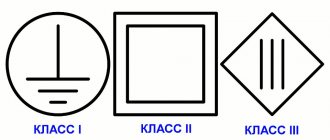The main point to pay attention to when working with any electrically powered equipment is safety. It is on this basis that a special classification of premises for electrical safety has been created. The quality of work performed by a person is influenced not only by skills, but also by the atmosphere in which the activity is carried out. If there are unpleasant gases or other impurities in the air, this will negatively affect performance. Additionally, the presence of vapors and high humidity in the air can dramatically increase the likelihood of electric shock from electrical equipment. Temperature indicators are also important.
Electrical Warning
Difference in working areas
In order to understand in more detail the degree of danger of electric shock, it is necessary to understand what kind of premises exist. There are three main categories of premises:
- Non-high hazard – these are work areas where there is no need to wear protective equipment, and there is no risk of electrical injury;
- High-risk areas are places where you need to wear special equipment for protection. There is a risk of receiving an electric shock from a certain device;
- Particularly dangerous areas are areas where only specialists wearing special protective equipment work. There is a high risk of getting an electric shock if safety rules are not followed.
Absolutely all premises used by a person in everyday life and work where electrical installations or any other electrical equipment are present are divided into such classes. The classification was created in order to minimize the risk of electric shock, since the likelihood of death if affected is quite high.
Important! Human life depends on compliance with safety precautions when staying in rooms with electrical equipment, therefore, when working with electrical installations, the established rules should not be neglected.
To study in more detail the level of danger of work in each individual work area, you should consider in more detail the classification of each room according to the danger of electric shock.
Categories of premises for electrical safety, PUE
In accordance with the rules of design, an electrical installation is a set of technological electrical equipment of machines and devices, together with the structures in which they are installed, intended for generation or transmission, transformation and redistribution, conversion into other types of energy. Are divided into:
- External (open). Located in open areas not protected from weather influences.
- Closed (internal). Located in buildings that protect them from atmospheric influences.
Electrical rooms are various structures, buildings or fenced off parts of the premises in which electrical equipment is located with access only to qualified personnel engaged in maintenance. All these electrical safety premises are divided into 4 categories:
- Premises without increased danger.
- Premises with increased danger.
- Particularly dangerous.
- Territories where open electrical installations are installed, where people can be electrocuted, are considered particularly dangerous areas.
1 category
The PUE states that these are premises in which there are no conditions for increased or special danger. What kind of premises are these?
Premises without increased danger are ordinary residential or office buildings. Social enterprises: preschool institutions, schools, hospitals and so on. Basic requirements for category 1:
- Dry - 60% and wet rooms where air humidity should not exceed 75%.
- Working supply and exhaust ventilation. There should be no conductive dust or chemical compounds in the air.
- The ambient temperature does not exceed +35°C.
- The floor covering must be made of non-electrically conductive materials.
Some production facilities and workshops can also be included in this category, but the above conditions must be met. Occupational safety requirements for employees are limited to introductory briefings and on-the-job briefings twice a year.
Specialists with the 3rd tolerance group up to 1000 volts are allowed to service electrical installations. The person responsible for electrical equipment is appointed from the engineering staff with the 4th group.
Category 2: hazardous premises for electrical safety
The current classification of premises according to the electrical safety of the Electrical Installation Code (PUE) includes those that meet the following criteria in the second category:
- Damp rooms. Humidity more than 75%
- There may be conductive dust in the air.
- Workshops with high levels of chemical compounds in the air.
- The floors are made of materials capable of conducting electricity (metal, earth, reinforced concrete, brick, etc.).
- Rooms with high temperatures.
- The ability to simultaneously touch a machine or other equipment on one side and metal parts (cases) of electrical equipment or exposed conductive parts on the other.
The list of enterprises and workshops that fall into this category is very large. Almost all enterprises, with the exception of especially dangerous ones, fall into this category.
It is mandatory to carry out occupational health and safety measures. In specialties related to work in hazardous and hazardous industries, additional training is provided with certification and admission of workers. Certification of workplaces is carried out.
At enterprises, it is mandatory to carry out an electrical inspection of the premises for electrical safety. Based on the findings of the examination, a category is assigned and a special sign (plate) is posted at the entrance, which indicates the electrical safety class of the room.
Only qualified specialists who have undergone training and have a clearance group in accordance with labor protection requirements when servicing electrical installations are allowed to perform maintenance.
Category 3: especially dangerous premises for electrical safety
Particularly dangerous electrical safety premises include those in which there is at least one of the following factors:
- Particularly raw. Air humidity 100%. Walls and equipment become covered with moisture that falls in the form of condensation.
- Premises with an active chemical or organic environment that occurs in the room during the work shift. This environment destroys electrical installation parts and wire insulation.
- If two factors related to high-risk conditions occur simultaneously.
This category of electrical safety premises has special requirements for the equipment and materials used. More frequent maintenance and repairs are provided. Only qualified personnel trained to work in certain conditions work. Labor protection, as a rule, classifies such production as hazardous.
Category 4: territories where open electrical installations are installed
The category of especially dangerous includes outdoor switchgear - open switchgear. Transformer substations, distribution centers consisting of a huge amount of electrical equipment. Located in an open area and surrounded by a fence. These are areas closed to unauthorized entry, where special industry requirements for labor protection and worker qualifications apply.
All premises certified for electrical safety must be marked with signs informing workers and representatives of regulatory authorities about the category of danger behind the doors.
Group I – no increased danger
Basic protection against electric shock
There is no visible threat here. There is no life-threatening equipment, and there is no need to work in protective clothing. Main characteristics:
- work is performed at normal temperatures;
- there is no high humidity in the workplace;
- the floor covering is made of materials that do not conduct electric current;
- there is a minimum number of electrical installations with proper grounding;
- complex metal structures are not available;
- there is no dust in the air or on the surface that conducts current;
- there are quite spacious areas, with a low level of space filling;
- work is performed with electrical installations whose power does not exceed 0.23 kV.
Such premises are in the first category in terms of the risk of electric shock and practically do not threaten human life.
Office space
Examples of such work areas are office buildings, separate computer centers, utility rooms, as well as administration or management offices.
What conditions affect electrical safety?
There are many factors that increase the risk of electric shock. First of all, it is water. In its pure form, it is a dielectric, but salts and other impurities dissolved in it are excellent conductors of electricity. Since distilled water does not exist in nature, this liquid should be considered as conductive. Accordingly, a high concentration of water vapor, leading to the formation of condensate, increases the likelihood of breakdown on the electrical equipment housing, creates the threat of a short circuit and increases the risk of direct or indirect contact with live elements.
Electrical appliances that pose a hazard in the bathroom
No less dangerous is the high concentration of tiny conductive particles in the air. Such dust settles on current-carrying elements of equipment, forming conductor paths along which electricity can pass to various metal structures. As a result, there is a direct threat to the lives of operating personnel, not to mention equipment failure and more serious consequences.
Dust is no less dangerous than water
Dust also interferes with heat dissipation by covering electrical equipment housings or settling on ventilation grilles. This leads to a violation of the temperature regime, which can cause a serious accident.
Speaking of excessive heat, this is also a destructive factor that affects electrical safety. High temperatures contribute to early wear of current-carrying elements and destroy their insulating coating. What this can lead to was described above.
Active chemicals are also hazardous. At a certain concentration in the air, they practically “eat” the insulation from the wires, destroy the contacts of switching equipment and form conductive chemical compounds.
To reduce the influence of destructive factors, it is necessary to apply certain measures described in the electrical safety requirements. For this purpose, a system has been adopted for classifying premises according to the degree of danger, with a detailed description of the regulatory requirements for each group.
The second group is increased danger
Types of electric shock
Premises are distinguished by other characteristics in terms of the degree of danger of electric shock. Here, work requires compliance with safety regulations, as well as the availability of special clothing. Basic conditions:
- increased air temperature, which often exceeds 30 degrees Celsius (according to the PUE);
- the floor covering is made of conductive materials, in addition, moisture often forms on the surface;
- increased air humidity, often exceeding 75%;
- additionally, the humidity level here may increase, often to the point of steam formation;
- there is dust in the building, which serves as a conductive material; it often forms on walls, cables, floors, as well as on equipment;
- the area is filled with various equipment up to 20%.
Such premises with respect to the danger of electric shock to people belong to the second category. When working in them, safety instructions must be given daily. Additionally, regular inspections are carried out.
Attic space
Examples of such work areas: attic spaces, vehicle service areas, repair shops, production facilities for certain products, rooms in which welding and other thermal work is carried out.
Occupational Safety and Health
The degree of safety of servicing electrical installations largely depends on the operating conditions and the nature of the environment of the premises in which the electrical equipment is installed.
Moisture, dust, caustic vapors, gases, high temperatures have a destructive effect on the insulation of electrical installations, thereby significantly)! deteriorate safety conditions.
In accordance with the rules for the construction of electrical installations, all rooms containing electrical installations are classified from the point of view of the danger of electric shock into the following three categories.
1. Premises without increased danger: dry, not hot, with a non-conductive floor, without conductive dust, as well as premises with a small number of metal objects, structures, machines, etc. or with an area fill factor k <; 0.2 (i.e., the ratio of the area occupied by metal objects to the area of the entire room).
2. Premises with increased danger: damp, in which, under normal conditions, the humidity can temporarily increase to saturation, as, for example, during sudden changes in temperature or when large amounts of steam are released; dry, unheated attics, unheated stairwells and heated rooms with short-term presence of moisture; rooms with conductive dust (coal mills, drawing shops and others like them); hot, i.e. rooms with temperatures above 30° C; rooms with conductive floors (earth, concrete, wood in a damp state).
3. Particularly dangerous premises: particularly damp premises; rooms with caustic vapors, gases and coolants that have a destructive effect on materials commonly used in electrical installations and reduce the resistance of the human body; rooms in which there are two or more danger signs (for example, a hot room and a conductive floor or a damp room with a fill factor of more than 0.2, etc.).
In order to avoid arbitrary interpretation of the definitions included in the classification of premises, according to the rules for the construction of electrical installations, premises with a relative humidity of not higher than 75% and a temperature of not lower than +5° C are considered dry, i.e. those in which the floor, walls and all items are normally in a dry state; Rooms with a relative humidity that constantly exceeds 75% or can temporarily rise to 100% are considered damp, since significant humidity can occur in these rooms when there is a sudden change in temperature or when a large amount of steam is released.
Particularly damp rooms are those in which the air is constantly saturated with water vapor, i.e. the relative humidity reaches 100% and as a result the floor, ceiling and all objects are constantly covered with moisture.
Rooms with conductive dust are those in which, due to the nature of production processes, electrically conductive dust (for example, coal, metal) can be released and collected in large quantities. This iin.ii, prevents the maintenance of proper insulation resistance of the electrical installation, and also reduces the resistance of the human body.
Rooms with caustic vapors or gases are those in which during the production process vapors or gases are released that have a destructive effect on insulating materials usually used in electrical installations. As a result, special measures must be taken to protect the insulation of electrical equipment. In addition to damaging the insulation of electrical equipment, these vapors and gases can also significantly reduce the resistance of the human body.
Hot rooms are characterized by high temperatures, causing drying and destruction of insulation, as well as excessive transpiration, increasing the risk of electric shock for persons in such rooms. A distinction is made between hot rooms - with temperatures above 30°C and especially hot rooms - with temperatures above 35°C.
Fire hazardous premises are those in which flammable objects are processed or stored or where production conditions may result in the formation of flammable gases, vapors, dust and fibers.
Explosive premises are those in which explosives are manufactured, processed or stored, or where explosive gases, vapors, or an explosive mixture with air can be formed.
The use of more advanced production technology, good ventilation and sealing makes it possible to significantly reduce the degree of danger in most industrial premises.
The conductivity of the floor is of particular importance for electrical safety. Dry end grain (without nails) or parquet floors have a fairly high resistance and are good at insulating a person from the ground. Conversely, brick, tile, concrete or earthen floors, whose resistance decreases sharply when wet, are poor insulators.
High-resistance floors can be a very effective protection measure. In shops with good end-grain, parquet or other high-resistance floors, single-phase contact may be less dangerous if the insulation is damaged.
As an analysis of electrical injuries shows, in enterprises with floors that have high electrical resistance, the possibility of electrical injuries during the operation of electrical equipment is significantly reduced. However, when touching two phases at the same time, the insulating properties of the floor do not matter and electric shock is inevitable.
Group III – especially dangerous premises
Personal protective equipment against electric shock
The third group of classification of premises according to the degree of danger is the most unsuitable for human work. If there are at least two additional characteristics from the second group of classification of premises according to the degree of danger of electric shock to a person, such a work area will be considered particularly dangerous. This category of premises has the following characteristics:
- air humidity at the site is often around 100%;
- Condensation often accumulates on the surface of electrical installations, walls, floors and ceilings;
- additionally, the air may contain corrosive gases and vapors of liquids, which can negatively affect the cable sheaths (corrode them);
- the presence of mold and fungal plaque in work areas.
Working in such conditions is allowed only with strict adherence to safety regulations, special education and special clothing. In addition, such work areas should be inspected regularly by electrical service personnel.
Production area
Examples of such premises are workshops of metallurgical plants, factories for processing various raw materials, oil production and processing stations, work areas for storing products, as well as battery departments.
Additionally, the hazard group assigned to a room is directly influenced by the classification of electrical installations used during operation. Previously, we looked at how premises differ in terms of the degree of danger to human life, but attention should also be paid to protective measures.
The equipment is working
5.4. Classification of electrical installations and premises
on electrical safety
A set of machines, apparatus, lines and auxiliary equipment (together with the structures and premises in which they are installed) intended for the production, transformation, transmission, distribution of electrical energy and its conversion into another type of energy is called electrical installations.
The basic requirements for the construction of electrical installations are set out in the current “Rules for the construction of electrical installations” (PUE).
From the point of view of measures taken to ensure electrical safety, electrical installations are divided into electrical installations with voltages above 1000 V in networks with an effectively grounded neutral (with high ground fault currents); electrical installations with voltages above 1000 V in networks with an isolated neutral (with low ground fault currents); electrical installations with voltage up to 1000 V with a grounded neutral; electrical installations with voltage up to 1000 V with an insulated neutral.
Grounded neutral
called the neutral of a generator or transformer, connected to a grounding device directly or through low resistance.
Isolated Neutral –
This is the neutral of a transformer or generator, not connected to a grounding device or connected to it through signaling, measuring, protection devices, grounding arc suppression reactors and similar devices that have high resistance.
The likelihood of electric shock and the severity of the outcome are influenced by the environment in which electrical installations are operated. Aggressive gases, vapors, and liquids destroy the insulation of electrical installations, reduce the insulation resistance, and create a threat of voltage transfer to non-current-carrying parts. This is facilitated by high temperature and humidity, and current-carrying dust, which also reduce the resistance of the human body.
Depending on the conditions that increase or decrease the risk of electric shock to a person, all premises are divided into:
• high-risk premises,
characterized by the presence in them of one of the following conditions that create an increased danger: dampness (relative air humidity exceeds 75% for a long time); high temperature (air temperature exceeds 35°C for a long time); conductive dust (coal, metal, etc.); conductive floors (metal, earthen, reinforced concrete, brick, etc.), the possibility of simultaneous contact with metal elements of technological equipment connected to the ground or metal structures of the building and metal casings of electrical equipment;
• especially dangerous premises,
characterized by the presence of high relative air humidity (close to 100%) or a chemically active environment that has a destructive effect on the insulation of electrical equipment, or the simultaneous presence of two or more conditions corresponding to high-risk premises;
• premises without increased danger,
in which all the above conditions are absent.
The danger of electric shock exists wherever electrical installations are used, so premises without increased danger cannot be called safe.
Many industrial premises are especially dangerous, for example, workshops of machine-building and metallurgical plants, water pumping stations, rooms for charging batteries, etc. In terms of the degree of danger, electrical installations outdoors are equated to electrical installations operated in particularly hazardous premises.
Carrying out protective measures
All premises are classified according to the level of possible degree of electric shock; it is recommended to carry out the following protective measures in such work areas:
- At the first stage, it is necessary to create a sufficiently high-quality ventilation system in the room - this will significantly reduce the risk of electric shock;
- When creating reliable electrical safety, special attention is paid to the floor covering - it is advisable that it does not act as a conductor;
- For rooms where there is a high probability of occurrence and accumulation of static electricity, it is not recommended to make flooring from dielectric materials;
- Workers should always receive timely safety instructions and wear protective clothing, which will significantly reduce the risk of electric shock.
Damaged cable
Electrical equipment is used everywhere, but it is not only useful, but can also cause an accident. This is why the condition of work areas should be assessed regularly. For this purpose, a special classification was created, based on which, premises of the first category do not need constant inspection, the second category should be checked at least once every six months, and as for hazardous work areas, inspections should be carried out regularly.
Related documents:
- work occurs at normal temperatures up to +5 degrees and relative air humidity up to 75% (according to the rules for the design of electrical installations (PUE);
- floor coverings are made of non-conductive materials: tiles, wood, linoleum and similar;
- minimum electrical installations to be grounded;
- there are no complex metal structures;
- there is no conductive dust in the air or on surfaces;
- Such premises are characterized by large areas and low space fill ratio;
- It is allowed to work with electrical devices with a voltage of 0.23 kV.
Electric Shock Conditions
Scheme of connecting a person to an electrical circuit.
Electric shock occurs when a current flows through a person as a result of the body being connected to an electrical circuit. The most typical are two connection schemes: between two wires (two-phase connection) and between a wire and ground (single-phase connection).
Two-phase connection is very dangerous, since in this case the most possible voltage in a given network is applied to the human body - linear.
Single-phase switching occurs many times more often, but is less dangerous than two-phase switching. With single-phase switching on, the voltage under which a person finds himself does not exceed the phase voltage, that is, less than linear UЛ by 1.73 times.
Accordingly, the current flowing through a person is also less. The magnitude of this current is affected by the neutral mode of the current source, the resistance of the floor on which a person stands, the resistance of his shoes and some other factors.
The influence of the environment on the degree of danger of electric shock.
The environment and surroundings increase or decrease the risk of electrical shock. Moisture, dust, high temperature, caustic vapors and gases have a destructive effect on the insulation of installations, increasing the risk of injury. Under these conditions, a person’s electrical resistance also decreases.
The impact of current on a person is also aggravated by the presence of conductive floors and metal grounded objects located close to electrical equipment, since simultaneous contact of a person with live parts and these objects will be accompanied by the flow of a large current through him.
Therefore, the current rules divide all premises according to the degree of danger of electric shock to people into three classes: 1) without increased danger; 2) with increased danger; 3) especially dangerous.
Premises without increased danger
– these are dry rooms with insulating (for example, wooden) floors, in which there are no conditions typical for high-risk and especially dangerous rooms.
An example of a room without increased danger would be ordinary living rooms and offices, sewing knitting shops, watch and instrument factories located in dry, dust-free rooms with insulating floors and normal temperature.
Premises with increased danger
characterized by the presence of one of the following conditions that create an increased danger: dampness (relative air humidity exceeds 75% for a long time); high temperature (air temperature exceeds +300C for a long time); conductive dust (according to production conditions, process dust is released in such quantities that it settles on wires and penetrates into electrical equipment); conductive floors (metal, earthen, reinforced concrete, brick, etc.), the possibility of simultaneous human touch to the metal structures of buildings, technological devices, mechanisms, etc. connected to the ground, on the one hand, and to the metal housings of electrical equipment - with another.
An example of a high-risk area would be the stairwells of various buildings with conductive floors, metal machining shops, television and radio equipment repair shops, even if they are located in dry heated buildings with insulated floors, etc.
Particularly dangerous premises
characterized by the presence of one of the following conditions that create a particular danger: special dampness, that is, in which the relative air humidity is close to 100% (walls, floors and objects in the room are covered with moisture); chemically active environment, that is, in which, due to production conditions, vapors are contained or deposits are formed that have a destructive effect on the insulation and live parts of electrical equipment; the simultaneous presence of two or more conditions characteristic of high-risk premises.
Examples of particularly dangerous premises are bathrooms in residential buildings, unheated basements with conductive floors, heating and industrial boiler rooms, laundries, chemical painting shops, etc. This also includes work areas on the ground, in the open air.
Scheme of connecting a person to an electrical circuit.
Electric shock occurs when a current flows through a person as a result of the body being connected to an electrical circuit. The most typical are two connection schemes: between two wires (two-phase connection) and between a wire and ground (single-phase connection).
Two-phase connection is very dangerous, since in this case the most possible voltage in a given network is applied to the human body - linear.
Single-phase switching occurs many times more often, but is less dangerous than two-phase switching. With single-phase switching on, the voltage under which a person finds himself does not exceed the phase voltage, that is, less than linear UЛ by 1.73 times.
Accordingly, the current flowing through a person is also less. The magnitude of this current is affected by the neutral mode of the current source, the resistance of the floor on which a person stands, the resistance of his shoes and some other factors.
The influence of the environment on the degree of danger of electric shock.
The environment and surroundings increase or decrease the risk of electrical shock. Moisture, dust, high temperature, caustic vapors and gases have a destructive effect on the insulation of installations, increasing the risk of injury. Under these conditions, a person’s electrical resistance also decreases.
The impact of current on a person is also aggravated by the presence of conductive floors and metal grounded objects located close to electrical equipment, since simultaneous contact of a person with live parts and these objects will be accompanied by the flow of a large current through him.
Therefore, the current rules divide all premises according to the degree of danger of electric shock to people into three classes: 1) without increased danger; 2) with increased danger; 3) especially dangerous.
Premises without increased danger
– these are dry rooms with insulating (for example, wooden) floors, in which there are no conditions typical for high-risk and especially dangerous rooms.
An example of a room without increased danger would be ordinary living rooms and offices, sewing knitting shops, watch and instrument factories located in dry, dust-free rooms with insulating floors and normal temperature.
Premises with increased danger
characterized by the presence of one of the following conditions that create an increased danger: dampness (relative air humidity exceeds 75% for a long time); high temperature (air temperature exceeds +300C for a long time); conductive dust (according to production conditions, process dust is released in such quantities that it settles on wires and penetrates into electrical equipment); conductive floors (metal, earthen, reinforced concrete, brick, etc.), the possibility of simultaneous human touch to the metal structures of buildings, technological devices, mechanisms, etc. connected to the ground, on the one hand, and to the metal housings of electrical equipment - with another.
An example of a high-risk area would be the stairwells of various buildings with conductive floors, metal machining shops, television and radio equipment repair shops, even if they are located in dry heated buildings with insulated floors, etc.
Particularly dangerous premises
characterized by the presence of one of the following conditions that create a particular danger: special dampness, that is, in which the relative air humidity is close to 100% (walls, floors and objects in the room are covered with moisture); chemically active environment, that is, in which, due to production conditions, vapors are contained or deposits are formed that have a destructive effect on the insulation and live parts of electrical equipment; the simultaneous presence of two or more conditions characteristic of high-risk premises.
Examples of particularly dangerous premises are bathrooms in residential buildings, unheated basements with conductive floors, heating and industrial boiler rooms, laundries, chemical painting shops, etc. This also includes work areas on the ground, in the open air.











